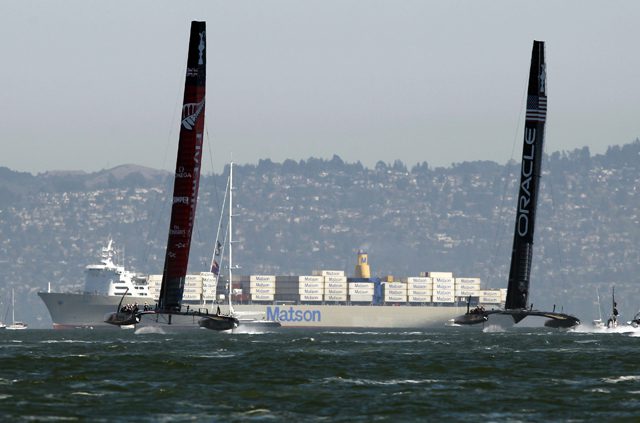Firms in Fed’s Beige Book Fret Over Any Lengthy Baltimore Port Closure
(Bloomberg) — The closure of one of the East Coast’s busiest ports after the collapse of Baltimore’s Francis Scott Key Bridge has so far not led to broad price increases,...


Emirates Team New Zealand (L) and Oracle Team USA sail near a container ship during Race 12 of the 34th America’s Cup yacht sailing race in San Francisco, California September 19, 2013. REUTERS/Robert Galbraith
By Aaron Kuriloff
March 6 (Bloomberg) — The catamarans used in the next America’s Cup will shrink about 16 percent and incorporate new safety and cost controls after last year’s regatta claimed the life of a sailor and cost about $100 million a team.
The new boats — which will still sail above the water at highway speeds — will measure about 60 feet, down from the 72- footers used in the last edition of the 162-year-old event, according to Pete Melvin, who is leading a team writing the design rules with Larry Ellison’s defending champions, the Australian challenger and several other contenders. The carbon wing-like sails used to power the yachts will be standardized, crew sizes will drop to about eight from 11 and teams will be restricted to one boat each to control costs, he said.
“We’re taking all the learning and most of the safety rules from the last Cup and folding those into the new rule as well,” said Melvin, a partner at Newport Beach, California- based Morrelli & Melvin Design & Engineering Inc. “Cost was a major driver and performance and potential innovation were others.”
The changes should yield boats no more than five or 10 percent slower than those used to contest last year’s regatta, in which Ellison’s Oracle Team USA defeated Emirates Team New Zealand 9-8 off San Francisco in the biggest comeback in Cup history, said Melvin, who worked as a designer for the Kiwis.
The U.S. team’s victory capped a series shaped by the Oracle Corp. chief executive’s vision and marred by tragedy. Pursuing the audiences of auto racing’s Formula One, Ellison’s planners advertised the world’s best sailors racing the world’s fastest boats — $8 million, 72-foot (22 meter) catamarans with 12-story vertical wings, capable of soaring above the surface on hydrofoils at speeds exceeding the posted 45-mile-an-hour (72- kilometer-per-hour) limit on the Golden Gate Bridge near the racecourse.
Sailor’s Death
A May 2013 training accident, however, killed Andrew Simpson, a British Olympic gold medalist and member of the Swedish team Artemis Racing. That accident, the second involving the new boats after Oracle flipped in October 2013, spurred four investigations, dozens of new safety rules and renewed debate over whether the technology used had advanced faster than sailors’ ability to control it.
Costs also hurt the regatta. With the price tag of a campaign eventually topping $100 million, only four teams participated, and Ellison, the world’s eighth-richest man according to the Bloomberg Billionaires Index, said after the races that expenses needed to come down to increase competition.
“We’re all going to sit down and talk about what kind of boats we want to use going forward,” Ellison said. “These boats are expensive and we’d like to have more countries competing next time, so we’re going to have to figure out how to accomplish both — get more countries competing next time but keep it as spectacular as it was this last regatta.”
Standard Wings
Standardizing wing design will help reduce the price of entry without significantly changing the boats, Melvin said. Teams of engineers were employed to develop the wings during the last Cup, yet didn’t yield significant differences between them, he said.
Meanwhile, the new boats will include additional controls to increase safe handling, such as adjustable elevators on their rudders similar to those on an airplane, Melvin said.
“If you don’t have elevators or your elevators are too small, you’re relying on weight placement and sail trim in order to control your pitch,” he said. “It’s kind of like if you were flying an airplane and you didn’t have a tail.”
Another change will allow hydraulic devices called “accumulators” to store power generated by the crew as the sailors turn large winches, Melvin said.
“That will help sail the boats more accurately and more safely, because you will have that pressure available in case you need it right away,” he said.
Speed Changes
Those changes probably won’t have a significant effect on the speed of the boats, which should be a bit slower while racing upwind and almost the same speed downwind as the 72- footers, Melvin said.
“Even during the Cup, the boats got something like 10 percent faster just in a few weeks of sailing,” he said. “We’re still on a vertical learning curve, so it wouldn’t be much of a surprise if these boats turned out to be faster than the 72s by the time the America’s Cup roles around.”
Copyright 2014 Bloomberg.
Join the gCaptain Club for curated content, insider opinions, and vibrant community discussions.


Join the 105,960 members that receive our newsletter.
Have a news tip? Let us know.
Access exclusive insights, engage in vibrant discussions, and gain perspectives from our CEO.
Sign Up




Maritime and offshore news trusted by our 105,960 members delivered daily straight to your inbox.



Essential news coupled with the finest maritime content sourced from across the globe.
Sign Up